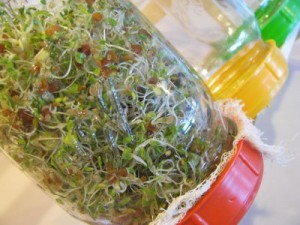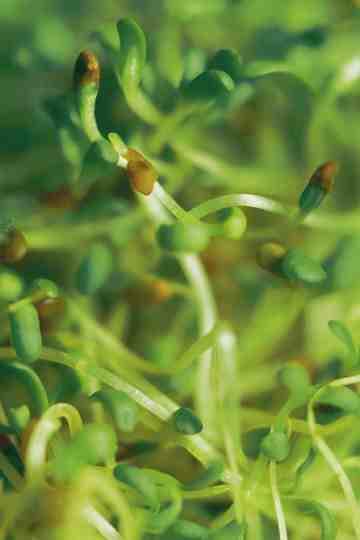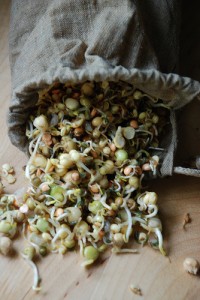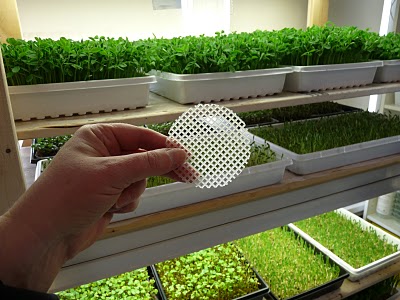 In Newfoundland and Labrador we produce a huge abundance and variety of leafy greens for a lot of the year, but they’re sparse come wintertime. If you're missing summer salads and need a boost after all the heavy holiday eating, there is a way to get local greens into your life way before spring, and it is so extremely simple. In your own kitchen you can easily grow the powerhouse of plants, the sultan of salads, the emporium of enzymes…sprouts! Sprouts are the first shoots that grow from germinating seeds and they carry all the necessary elements that will help a seed to become a mature plant. When you eat sprouts you’re giving your body all those jam-packed vitamins, minerals, proteins, and enzymes and essentially eating a living food. If you start sprouting now you won’t want to stop after winter. All year round you can grow one of the healthiest and most local foods right in your kitchen for almost no cost and with little effort. The options are endless for sprouting in terms of what to sprout, how to sprout it, and what to use the sprouts for.
In Newfoundland and Labrador we produce a huge abundance and variety of leafy greens for a lot of the year, but they’re sparse come wintertime. If you're missing summer salads and need a boost after all the heavy holiday eating, there is a way to get local greens into your life way before spring, and it is so extremely simple. In your own kitchen you can easily grow the powerhouse of plants, the sultan of salads, the emporium of enzymes…sprouts! Sprouts are the first shoots that grow from germinating seeds and they carry all the necessary elements that will help a seed to become a mature plant. When you eat sprouts you’re giving your body all those jam-packed vitamins, minerals, proteins, and enzymes and essentially eating a living food. If you start sprouting now you won’t want to stop after winter. All year round you can grow one of the healthiest and most local foods right in your kitchen for almost no cost and with little effort. The options are endless for sprouting in terms of what to sprout, how to sprout it, and what to use the sprouts for.
It may take a while for you to get used to the idea of sprouts as a staple food, especially if you’re more familiar with a meat and potatoes type diet in the winter. But if you begin slowly, growing just a few and using them as garnish to start, you’ll already begin to see the advantages for your health, especially if your fresh food consumption has gotten really low over the winter. You may even get hooked on the benefits that sprouts provide, and surprisingly find yourself eating sprout salads, breakfasting on green smoothies, and looking up recipes for sprouted bread. Stranger things have happened!
Sprout Year-Round in NL
Root Cellars Rock! had the chance to connect with local  sprouting mentor Julie Graham in St. John's to ask her about why she grows these green gems year-round.
sprouting mentor Julie Graham in St. John's to ask her about why she grows these green gems year-round.
What is it about sprouting that you like?
Julie: I like that its really healthy and fresh food that you can control at home. You watch every step that went into growing it and it’s delicious.
Can you tell us about some of the health benefits of eating sprouts? Have you noticed a difference in how you feel when you eat them?
Julie: All the good stuff in sprouts, vitamins and nutrients, seem easier to absorb than in other vegetables. It feels good to be eating live foods that feel awake, and I think our bodies like that a lot. I always just in general feel better when I’m eating lots of green foods, lots of salads. Sprouts are really good because you can make them all winter and you can add them to almost any meal and you instantly have a whole pile of nutrients there.
Do you have any tips for someone that is new to sprouting?
Julie: Start small sprouting less than 2 tablespoons of seeds because it’s easy to try to do too much. A spoonful of seeds turns into a full jar of sprouts. When I was starting I would put way too many seeds in and it would make too many sprouts. I kind of stick to the 2 tablespoon general rule even though I’ve been doing it for a long time. And make sure to use up all the sprouts you grow, eat them all the time. Don’t save them for future meals, just eat them right away and keep making more. Experiment with all kinds of different seeds and grains. I still am experimenting. Find out what you like best. All sprouts taste a bit different so naturally people are going to like certain ones more than others.
What do you sprout?
Julie: Usually I sprout some kind of alfalfa type seed. It has a pretty neutral flavour and you can add it to anything, even smoothies for example. I also usually do more of a sandwich or salad mix that that I sort of made up and experiment with. A good place to start is with the Mumm’s sprouting seeds, they have pre-mixed little blends and I’ve kind of based mine off of theirs. One is spicy lentil crunch with about six different seeds in it with pretty strong flavours and it’s nice on sandwiches and salads. I also like to soak almonds and pumpkin seeds and sunflower seeds. You can just soak them overnight and then drain them and rinse them and eat them right away. If you sprout them all the way they taste more like a vegetable. But if you just soak them overnight they keep their nutty flavour but the nutrients are more available.
How do you like to use your sprouts?
Julie: I really, really like them on sandwiches or crackers, with hummus or cream cheese. In salads they’re really good. In the winter I make a lot of salads out of grated carrots, grated beets and sprouts. We use pretty much local foods all year round and they make really amazing salads in the winter. I put sprouts in smoothies and I just eat them plain.
What Can Be Sprouted?
Most varieties of seeds, nuts, grains, and beans can be sprouted. Some definitely taste better than others and grow more easily. Common ones include: alfalfa, sunflower, mung beans, chickpeas, almonds, fenugreek, lentils, radish, quinoa, millet and clover. Choose raw, organic varieties and make sure they're not pre-cooked, in brine, very old, chemically treated, or salted because then they won't sprout. Your best bet for first-time success is to purchase a package of sprouting seeds at a local health food store, in the health food aisle of a grocery store, or from a sprouting seed company like Mumm's. There are so many possibilities for what you can sprout, experiment with different raw, organic seeds, nuts, grains, and beans as you get the hang of it. You could even save some from your home or community garden for sprouting as well. For safety, make sure you rinse your sprouting seeds well regardless of what method you're using, don't use seeds that are from a plant that could be poisonous, and store sprouts properly after they've grown, composting them instead of eating them if you see any signs of degeneration or mold.
sunflower, mung beans, chickpeas, almonds, fenugreek, lentils, radish, quinoa, millet and clover. Choose raw, organic varieties and make sure they're not pre-cooked, in brine, very old, chemically treated, or salted because then they won't sprout. Your best bet for first-time success is to purchase a package of sprouting seeds at a local health food store, in the health food aisle of a grocery store, or from a sprouting seed company like Mumm's. There are so many possibilities for what you can sprout, experiment with different raw, organic seeds, nuts, grains, and beans as you get the hang of it. You could even save some from your home or community garden for sprouting as well. For safety, make sure you rinse your sprouting seeds well regardless of what method you're using, don't use seeds that are from a plant that could be poisonous, and store sprouts properly after they've grown, composting them instead of eating them if you see any signs of degeneration or mold.
Sprouting Methods
There are lots of ways to sprout. Here are a few videos that can get you started with different sprouting techniques. Choose one based on the materials you have on hand and how easy you find the method.
Mason Jar Sprouting: Very inexpensive and easy. This is the most commonly used method.
Cheese Cloth & a Kitchen Pot: This works well if you’re growing bigger sprouts and if you’re sprouting things that prefer full darkness to grow, like mung beans.
Sprouting Bag: You can make your own using untreated fabric and string.
Sprouting Tray: Works well for growing more sprouts at once or for preparing sprouts for soil.
Sprouting Tray & Sprouting Bag: Check out the tray in this video. It’s part of a somewhat expensive sprouting unit. But you’ll see that it’s similar to inexpensive plastic trays you would buy for other uses, which could be adapted to sprouting.
Sprouts on Soil: Sprouting using soil is a nice way to keep sprouts going for a longer period of time, where you’re basically pruning as needed rather than eating as soon as they’re ready. Try growing them on your kitchen counter or office desk to provide a healthy snack in easy reach.
 There are lots of companies that sell sprouting equipment, like bags, screens, lids, trays and automatic sprouting units. If you’ve really gotten into sprouting then this gear can be helpful, but you don’t need to spend a lot of money to buy the equipment. Most of it can be made at home with readily available materials. There are lots of resources online to help you make these things yourself.
There are lots of companies that sell sprouting equipment, like bags, screens, lids, trays and automatic sprouting units. If you’ve really gotten into sprouting then this gear can be helpful, but you don’t need to spend a lot of money to buy the equipment. Most of it can be made at home with readily available materials. There are lots of resources online to help you make these things yourself.
Recipes
So you’ve grown some nutrition-packed sprouts and you’ve enjoyed eating them as they are, but you’re interested in taking it up a notch and using sprouts more creatively in your meals. Home-sprouted foods can be a great addition to a potluck or dinner party because they’re sure to spark conversation. They’re also easy to incorporate into many of your regular recipes to boost nutritional value. And if you’re trying to detox after the holidays, eating lots of fresh foods, including sprouts, can help your body feel rejuvenated. Keep in mind that you can mix and match sprouts, so if a recipe calls for alfalfa sprouts, you can swap in other kinds instead too. Here are some recipes anthologies to get you experimenting:
International Sprout Growers Association
If you have any sprouting questions, tips, resources, or recipes to share, please feel free to leave them in a comment below, and enjoy your new green foods! All of the videos from this post can be found on our Youtube channel under Planting.


